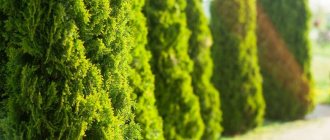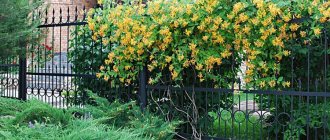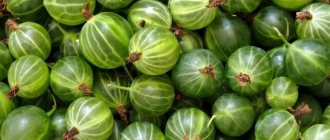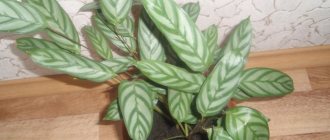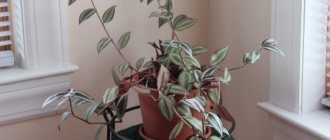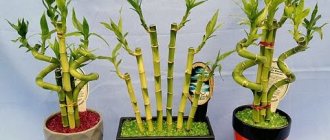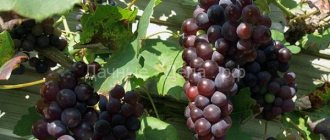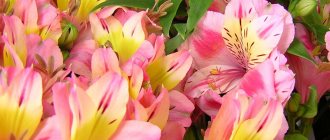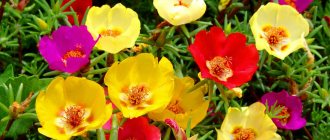Description of Juniperus horizontalis
Juniper horizontalis, commonly called creeping or prostrate, is a creeping evergreen shrub of the genus Juniperus. It typically grows in rocky or sandy soils, including rock outcrops, rocky slopes, coastal cliffs, and stream banks.
It is a low ground cover plant that usually reaches 50 cm in height, but spreads with long pendulous branches with numerous short branchlets, often forming a dense mat up to 2 meters wide. The foliage is mostly scale-like with some awl-like needles. During the growing season, the foliage is usually green or blue-green, but often turns purple in winter.
The plant is characterized by slow growth, the maximum annual growth is about 10 cm. It bears fruit with dark blue spherical cone berries. The fruit ripens one year after formation.
You might be interested
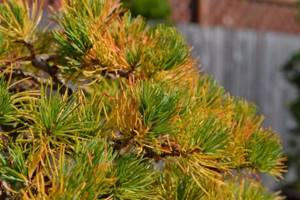
Why do coniferous trees turn yellow?
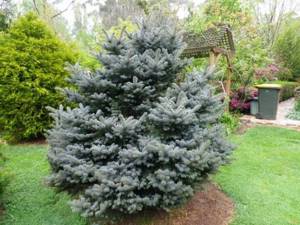
What fertilizers for coniferous plants can be used in the garden

How to care for coniferous plants in your garden
Juniperus rocky Skyrocket
A variety that deserves attention due to its incredible endurance to any adverse conditions. It takes root well on any type of soil and tolerates both drought and rainy periods equally well.
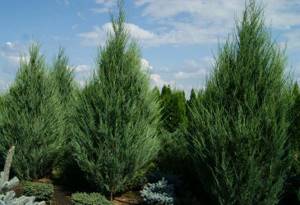
Skyrocket are tall trees that are mainly planted along the perimeter of the site. The alleys from Skyrocket resemble cypress trees. With a columnar shape and a height of 4 m, the width is only 40 cm, so in strong winds the trunk needs spacers for centering. In winter, snow should be shaken off the branches so that they do not break off under heavy weight.
Related article:
Survive the cold without loss: 5 reliable ways to protect conifers in winter
Planting and caring for Horizontal Juniper
This trailing plant is easy to grow and care for. Let's take a look at the various requirements that you must provide for the smooth growth of your ground cover plant.
The soil
Like many ground covers, Creeping Juniper can grow in a variety of soils. However, it prefers sandy soils with average moisture and excellent drainage. It does not tolerate wet soil, so either make sure the soil is porous enough or add some perlite or sand.
Light
Although juniper bushes do not require much light, they grow best in full sun.

Juniper cones
So, if you are planning to plant them in your yard, make sure that you do not plant them in the shade.
Water
Prostrate juniper bushes are drought tolerant, making them an ideal ground cover in hotter climates. When planting for the first time, you need to be sure to give them plenty of water. Once established, the plants will live longer without watering.
Fertilizers
These ground cover plants usually do not need much fertilizer. Don't fertilize the first year it gets established. The plant should be fed in the spring by adding organic fertilizers to the soil. You can use a well-balanced, complete fertilizer typically used for coniferous shrubs and trees.
Transfer
Creeping juniper can be replanted at any time of the year, except extreme winters. Spring or early fall is the ideal time to move your plant. All you need to do is dig up the plant and replant it somewhere else.
Pruning creeping juniper
Most of the time it does not require pruning or trimming. You can remove dead branches or prune if it is growing out of bounds, but we recommend choosing a variety that suits the size of the area you are planting.
Features of care
Gardening stores sell seedlings with a closed root system. They can be planted at any time of the year. The main thing is to give the young juniper a lot of water in the first weeks of life in the ground. Most subspecies are light-loving. There are shade-tolerant ones, but it is still better to place them in sunny areas. This will have a beneficial effect on the decorative appearance of juniper.

It is advisable to grow the crop in slightly alkaline soil. The nutritional requirements are modest. At a young age, the annual growth of shrubs is worse than in adulthood. But the nutritional value of the soil will not affect this.
The plant does not require fertilizing. But juniper likes high humidity. During hot periods of summer, spray the area above and around the plant. Also provide the crop with regular watering in small portions.
Prostrate juniper is rarely replanted, unless absolutely necessary. The root is quite firmly fixed in the soil layer. It is difficult to remove it from tall members of the family without damage. Miniature ground covers are a little easier to work with.
Advice. Replant in early spring. Dig up the crop with a clod of earth. The orientation of the bush relative to the cardinal points in the new place should correspond to the previous one.
Reproduction of Juniperus horizontalis
Juniper horizontal or prostrate propagates by seed or cuttings. The seed method is used extremely rarely; there is a high probability of loss of varietal characteristics of the plant.
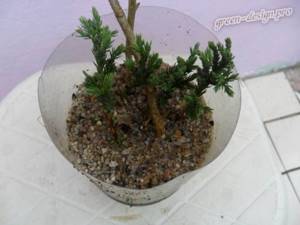
Semi-lignified branches are chosen for cuttings. Harvesting is carried out in mid-spring. A cutting from an adult shrub, about ten centimeters long, must have a “heel”. The part of the branch buried in the soil is freed from needles and treated with an agent that stimulates the growth of the rhizome. The seedling immersed in moist soil is covered with a protective cap.
Planting is done in a mixture of sand and peat mixed in equal proportions. The planting is regularly moistened to prevent excessive drying out. A seedling with a developed root system can be moved to open ground in mid-summer. In the first years after planting, the bushes need to be additionally covered in winter. Mature plants have sufficient strength and do not require additional protection.
Problems in caring for shrubs
Pests of Juniper horizontalis
Spider mites and various types of aphids are the main insects that harm the plant. If you notice these pests, use one of the many different organic control methods or consult our pest removal tips.
You might be interested

Getting rid of aphids in the garden using effective methods

Spider mites: how to deal with the pest
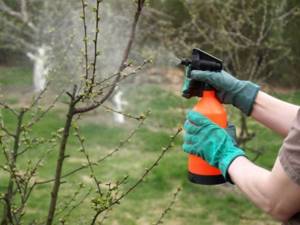
Pest control in the garden in spring: methods and timing
Diseases
If you notice yellowing needles on your Juniper groundcover, this indicates a fungal infection. When you discover a problem, be sure to carefully trim off the affected parts of the plant. Sterilize your pruning shears before using them on other plants. Otherwise, the fungal disease will spread throughout the garden as you use the shears elsewhere.
The use of horizontal juniper in landscape design
Thanks to the creeping structure of the crown, the shrub is used to create plant carpets and decorate various stone gardens.
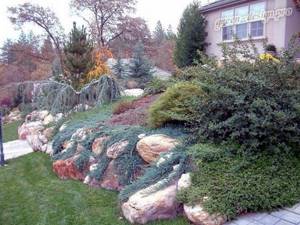
It is grown in container plantings, decorating gazebos and open areas of country houses. Juniper beautifully and harmoniously supports the style of the combined plant composition. There are several options for using this coniferous plant in garden design.
Plant a shrub on a steep slope
You will be glad to see the plant quickly growing throughout your area. But if you have a hilly area that needs to be mowed often, plant creeping juniper on the hill, thereby solving one of the big problems associated with caring for the area - mowing grass on a slope.
It will prevent weeds and grasses from growing and will decorate your area.
Juniper horizontal in the winter garden
In winter, when deciduous crops become bare, this shrub will become one of the spectacular accents in your garden, decorating the garden during the cold season.
Landscaping of the front garden
As a low-growing plant, this groundcover fits easily into a front garden design. Creeping juniper can be used as a border plant separating a garden path from a lawn or flower bed.
Decoration of stone retaining walls
People love the way the plant's branches cascade down the wall, decorating stone or brick structures.
Stone gardens
In these decorative compositions, the horizontal juniper is one of the main favorites, without which it is impossible to imagine any rock garden or rock garden.
Coastal juniper Blue Pacific
A variety of Japanese selection that looks very attractive. It is not worth planting it along the border area of pedestrian paths, as the needles are very prickly. The bush grows quickly, in adult specimens the height does not exceed 40 cm with a diameter of 1 m. Blue Pacific is often used for grafting onto a standard; the result is a lush crown with drooping branches. This form is very beautiful, but it is more vulnerable to severe frosts.
Related article:
Ideal conifers for a summer cottage: 6 best varieties of decorative spruce
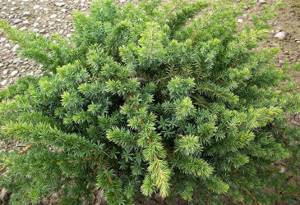
Varietal diversity of Juniperus horizontalis
Due to its popularity, visual beauty, and ease of care, this type of coniferous crop is especially popular among gardeners. The varietal diversity includes about 100 different variations. The varieties most suitable for our climate zone:
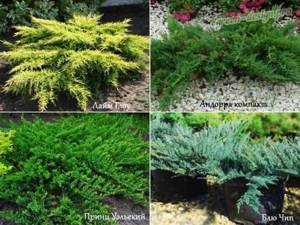
Juniper horizontal "Blue Chip"
Low growing plant. The height of the branches is about 30 cm, the crown is one and a half meters in diameter. The needles are short, sharp and bluish-gray in color. In the cold season, it acquires a bluish, brown tint. Spherical cone berries are black. The variety is adapted to life in polluted city conditions. Often used in container plantings, decorating the terraces of street restaurants.
M. horizontal "Andorra compact"
The maximum height of the bush reaches forty centimeters, the volume is one meter. The dense crown has a cushion shape. The color is ash green. The berries are round in shape, gray-blue in color.
Juniper horizontal "Lime Glow"
The shrub has a symmetrical, rounded crown shape. The height of the branches is up to 40 cm, the diameter of the crown is 1.5 m. It is distinguished by the lemon-canary color of the needles, which is preserved only on specimens growing in illuminated areas.
Juniper Cossack Arcadia
One of the hardiest varieties. It is often used as a “vertical lawn” because it can quickly overgrow a large area around it. It grows in width, but the height does not exceed half a meter. To create a continuous lawn, bushes are planted at a distance of about 1 m from each other.
Related article:
How to trim thuja correctly

It stands out for its unusual color for Cossack juniper - light green. The very dense crown has single towering shoots, which creates the impression of openwork. Arcadia tolerates pruning well, so you can shape it to your liking.
